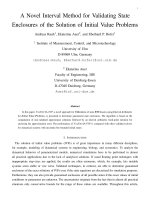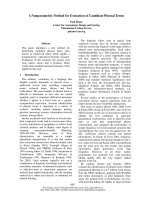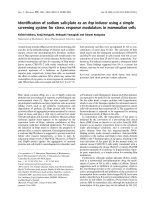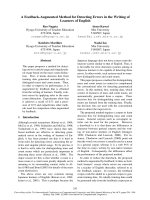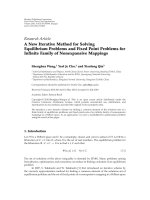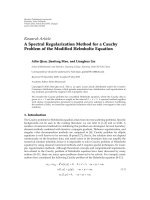A simple, microwave-assisted method for synthesis of Thalidomide
Bạn đang xem bản rút gọn của tài liệu. Xem và tải ngay bản đầy đủ của tài liệu tại đây (230.02 KB, 9 trang )
Journal of military pharmaco-medicine n02-2019
A SIMPLE, MICROWAVE-ASSISTED METHOD FOR
SYNTHESIS OF THALIDOMIDE
Vu Binh Duong1; Ho Ba Ngoc Minh1; Nguyen Quynh Hoa2; Phan Dinh Chau3
SUMMARY
Objectives: To investigate the conditions for the synthesis of thalidomide in two-step with the
assistance of microwave irradiation resulted in high overall yield. Method: Preparation of
thalidomide which comprises reacting anhydride phthalic with L-glutamic acid to afford Nphthaloyl-DL-glutamic acid, which is further subjected to cyclization with ammonia donor
sources (urea, ammonium acetate, thiourea) in presence of 4-dimethyl-aminopyridine and
diphenyl either to give thalidomide. Results: Investigating the conditions of the reaction including
temperature, duration and mode of reaction; ratio of reactive agents of preparation of
thalidomide. From these results, we found out the conditions to synthesize this compound.
Conclusion: An improved synthesis for thalidomide was established. It produced a total yield of
72% over two steps.
* Keywords: Thalidomide; Phthalic acid; L-glutamic acid; Synthesis.
INTRODUCTION
Thalidomide (I)/(N-phthalimidogluatarimide)/
was first marketed in West Germany by
Chemie Grunelthal GmbH as a clinically
effective and extremely safe non-barbiturate
sedative-hypnotic in 1957 [1]. This drug
was used therapeutically as sedativehypnotic from 1958 to 1961. It became a
popular drug in Europe, Japan, and Canada
with a variety of trade names: Contergan®,
Isomin®, and Distaval®, for example. In
1961, W. Lenz [2] and W.G. McBride [3]
realized the unexpected potent teratogenicity
of thalidomide. The teratogenic side
effects, leading to birth defects such as
limb reduction, produced one of the most
notorious medical disasters in modern
medical history and thalidomide was
consequently withdrawn from the market
in 1962.
However, the unique and broad
physiological effects of thalidomide have
gradually revealed in succession with the
discovery of its effectiveness toward other
diseases as leprosy, rheumatoid arthritis,
neoplastic diseases, HIV/AIDS, multiple
myeloma, mesothelioma, Crohn’s diseases,
cancer-related to pathologic angiogenesis,
1. Vietnam Military Medical University
2. National Centralized Drug Procurement Center
3. Hanoi University of Science and Technology
Corresponding author: Vu Binh Duong ()
Date received: 20/12/2018
Date accepted: 25/01/2019
102
Journal of military pharmaco-medicine n02-2019
and other diseases. Thus, in 1998, Celgene
gel [11a]; (3) Using toxic solvents/materials;
received thalidomide FDA approval to use
(4) Procedure have lot of steps [1,11a];
thalidomide (thalomid) for the treatment of
(5) Low overall yields [10b]. Usually, in
ENL. More recently, thalidomide has been
finishing step - the conditions employed
connected with the treatment of several
for cyclization of the glutarimide-ring
diseases such as leprosy [4], AIDS [5],
including the condensation of Na/liquid or
Crohn’s diseases [6], rheumatoid arthritis
gas ammonia at high pressure [10b]; the
[7], cancer-related to pathologic angiogenesis
reaction urea/thiourea in melting mixture
[8] and it is still under study for other
at high temperature [1], the cyclization of
diseases [9].
the amide with CDI/4-DMPA or CDT/4-
However, due to its catastrophic effect
DMAP [11c]. These conditions can often
on fetal malformation, it was banned in the
cause low yields, longer reaction times
early sixties. In recent years, the concerns
and byproduct formation. That is, none of
about this drug has been on the increase
these procedures is practical in terms of
for the treatment of the above-mentioned
industrial scale-up operations.
diseases attracting interest in the development
Several groups have reported the
of new improved synthetic approaches of
synthesis of thalidomide (I) from phthalic
thalidomide and its derivatives.
anhydride (II) via three or four steps with
A number of publications about the
relatively low overall yields
[1, 10b]
synthesis of thalidomide were reported
whereby N-carbethoxylation of II produces
from starting pair of materials or different
N-carbethoxy-phthalimide (III), respectively.
starting materials such as: anhydride
Conversion
phthalic and L-glutamic acid [10]; phthalic
glutamic acid (IV) with L-glutamic acid
anhydride and L-glutamine [11]; phthalic
and sodium carbonate in water and then
anhydride and 2.6-dioxo-3-amino-pyridine
esterification of IV with methanol and
or its derivatives [12]. Although these
thionyl chloride in reflux conditions give N-
synthetic procedures seem to be straight
phthaloyl L-glutamic acid dimethyl diester
forward transformations, they suffer from
(V). Finally, the compound V was treated
several drawbacks on the large-scale
with sodium amide (prepared in situ from
preparation: (1) Use of costly starting
metal and ammonia in the presence of
reagents/materials in the steps involved
iron (III) nitrate in liquid ammonia and
the preparation; (2) Reactions carried out
ammonium chloride to afford white solid,
involving a high melting temperature
which was purified by column chromatography
requiring multiple recrystallizations [1] or
to give thalidomide, with low overall yields
purified by column chromatography on silica
(19% from III) (Scheme 1) [10b].
of
III
to
N-phthaloyl-DL-
103
Journal of military pharmaco-medicine n02-2019
O
O
O
(a)
N-COOC2H5
O
O
(b)
N
O
II
O
III
O
COOH
COOH
IV
O
(c)
N
COOCH3
COOCH3
O
(d)
N
NH
O
O
V
O
I
Scheme 1: Four-step synthesis of thalidomide (I) from phthalic anhydride (II) and
e4dsxzL-glutamic acid [10b].
(Reagents and conditions: (a) i, NH3/high temperature and pressure; ii, ClCOOC2H5;
(b) L-glutamic acid/Na2CO3/0oC/5 mins + RT/40 mins, 60%; (c) Methanol/SO2Cl2
/reflux/6h/purified on column chromatography, 71%; (d) Na/liquid NH3/Fe3NO3, 45%)
MATERIALS AND METHODS
RESULTS AND DISCUSSION
All of the commercially available
reagents and solvents were used without
further purification. The 1H-NMR and 13CNMR spectra were measured in CDCl3 on
Bruker-AV500 spectrometer; the chemical
shifts were reported in ppm relative to
TMS. The IR spectra were recorded in the
solid state as KBr dispersion using a GXPerkin Elmer spectrophotometer (USA).
The mass spectra (70 eV) were recorded
on AutoSpec Premier Spectrometer. The
melting points were measured on Stuart
SMP-10 apparatus. Analytical thin layer
chromatography (TLC) was carried out on
Merck pre-coated aluminum silica gel
sheets (Kieselgel 60F-254). Sineo
Microware Chemistry Technology UWare1000 (China).
In this report, the pair of starting
materials phthalic anhydride (II) and Lglutamic acid was chosen for the
preparation of intermediate N-phthaloylDL-glutamic acid (IV), because of high
cost. The IV was prepared by treatment of
II with L-glutamic acid in pyridine at 115oC
for 15 mins by microwave irradiation and
then the reaction mixture was added to
water and adjusted pH to 1.2 with 6N HCl
solution. The product as white solid was
separated, filtered and washed with
cooled water to afford IV in 90%. This
material requires no further purification in
the next step. The mixture of IV, thiourea
(as a source of ammonia) and diphenyl
ether in presence of 4-DMAP was heated
by microwave irradiation at 178oC for 12
minutes after work-up receive thalidomide
(I) in 80% (scheme 2).
104
Journal of military pharmaco-medicine n02-2019
O
O
O
(a)
N
O
(b)
COOH
COOH
N
O
O
O
O
II
O
NH
IV
I
Scheme 2: Two-step synthesis of thalidomide from phthalic anhydride and
L-glutamic acid.
(Reagents and conditions: (a) L-glutamic acid/pyridine/115oC/15 mins, 89% (b)
Thiourea/4-DMAP/diphenyl ether/178oC/15 mins, 81%)
- Synthesis of N-phthaloyl-DL-glutamic acid (IV): Compound IV was prepared from
phthalic anhydride (II) and L-glutamic acid. In this reaction, the mixture of II, L-glutamic
acid and pyridine was stirred and heated to 115oC by microwave apparatus. This
method bypassed the carbethoxylation of II to afford III (scheme 1, step a), thus
eliminating the need for preparation of N-carbethoxy-phthalimide (III). This change
reduced one step of the procedure. In addition, the parameters of procedure as solvent
type (table 1); the reaction temperature (table 2); the water volume using in isolation of
N-phthaloyl-DL-glutamic acid (IV) from reaction mixture (table 3); the molar ratio
between reactants (table 4); the pyridine volume used in reaction (table 5) was optimized.
Table 1: Effect of reaction solvent on the yield of N-phthaloyl-DL-glutamic acid (IV).
No.
Solvent
Temperature
0
N-phthaloyl-DL-glutamic acid (IV)
0
( C)
Weight (g)
Melting point ( C)
Yield (%)
1
Pyridine
115
11.66
191 - 193
84.21
2
DMF
153
10.32
191 - 192
74.54
3
Dioxane
101
6.72
191 - 193
48.54
4
4 mL dioxane + 1 mL DMF
101
6.94
192 - 193
50.10
5
Acetonitrile
81
9.63
192 - 193
69.55
The optimal solvent was pyridine (N01).
Table 2: Effect of reaction temperature on the yield of IV.
N-phthaloyl-DL-glutamic acid (IV)
No.
Temperature (°C)
0
Weight (g)
Melting point ( C)
Yield (%)
1
115
11.66
191 - 193
84.21
2
100 - 102
11.13
191 - 192
80.38
3
80 - 82
10.30
191 - 192
74.34
105
Journal of military pharmaco-medicine n02-2019
The reaction temperature gives the best yield of IV was 115°C (No.1).
Table 3: Effect of reaction water volume on the yield of IV.
N-phthaloyl-DL-glutamic acid (IV)
No.
Water volume (mL)
0
Weight (g)
Melting point ( C)
Yield (%)
1
45
11.66
192 - 193
84.21
2
60
12.04
191 - 193
86.92
3
75
11.80
191 - 192
85.17
The optimal water volume was 60 mL (No.2).
Table 4: Effect of molar ratio between anhydride phthalic and L-glutamic acid on the
yield of N-phthaloyl-DL-glutamic acid (IV).
N-phthaloyl-DL-glutamic acid (IV)
Molar ratio of anhydride
phthalic and L-glutamic acid
Weight (g)
Melting point ( C)
Yield (%)
1
1:0.9
11.24
192 - 193
81.17
2
1:1
12.05
191 - 193
87.03
3
0.9:1
11.12
191 - 192
80.29
No.
0
The result found that using molar ratio of anhydride phthalic:L-glutamic acid was 1:1,
which got the highest yield (No.2).
Table 5: Effect of solvent volume on the yield of N-phthaloyl-DL-glutamic acid (IV).
N-phthaloyl-DL-glutamic acid (IV)
No.
Pyridine volume (mL)
Melting point ( C)
Yield (%)
1
3
9.86
191 - 193
71.18
2
4
10.88
192 - 193
78.56
3
5
12.32
191 - 193
88.92
4
6
11.38
191 - 192
82.17
5
7
11.32
192 - 193
81.73
The optimal pyridine volume with the
highest yield was 5 mL per 0.05 mole
anhydride phthalic (No.3).
- Synthesis of thalidomide (I): Compound
I was synthesized in one step from IV by
heating a mixture of IV, thiourea (ammonia
donor source), 4-DMAP as catalytic, diphenyl
either in microwave apparatus instead of
106
0
Weight (g)
two steps were esterification of IV with
methanol/SO2Cl2 to afford ester V and
then the formation the glutarimide-ring
from V by using the NaNH2/liq.NH3/
Fe(NO3)3. The parameters of this step
were also optimized for cyclization of
glutarimide-ring, which resulted in the
reaction temperature (178oC) and a
Journal of military pharmaco-medicine n02-2019
shorter reaction time (15 mins). Those
parameters consist of the ammonia donor
source; the power of microwave and the
reaction temperature; the molar ratio
between thiourea:compound IV; the
solvent type which used in reaction; and
the diphenyl ether volume used in
reaction (table 6 - 10). Finally, the method
of separation and purification of I was also
investigated. As a result, there was no
need to column chromatography for the
purification of thalidomide.
Table 6: Effect of ammonia donor source on the yield of thalidomide (I).
Thalidomide
No.
Ammonia donor source
0
Weight (g)
Melting point ( C)
Yield (%)
1
Urea
3.21
269 - 271
62.23
2
Thiourea
3.75
269 - 270
72.65
3
Ammonium acetate
3.08
269 - 271
59.61
4
Ammonium chloride
1.56
270 - 271
30.31
The result found that using thiourea as ammonia donor source got the highest yield
of I (No.2).
Table 7: Effect of reaction solvent on the yield of thalidomide.
No.
Solvent
Thalidomide
o
Temperature ( C)
0
Weight (g)
Melting point ( C)
Yield (%)
1
DMF
153
2.02
269 - 270
39.19
2
DMA
165
2.08
269 - 270
40.23
3
Ph2O
180
3.74
269 - 271
72.55
The optimal solvent was diphenyl ether (No.3).
Table 8: Effect of reaction temperature on the yield of thalidomide.
Thalidomide
No.
Temperature (°C)
0
Weight (g)
Melting point ( C)
Yield (%)
1
160
3.58
269 - 270
69.43
2
170
3.75
269 - 271
72.65
3
175
3.93
269 - 271
76.21
4
180
3.95
269 - 271
76.55
5
185
3.89
270 - 271
75.36
6
200
3.62
269 - 270
70.17
The reaction temperature gives the best yield of I was 178°C (between 175 and
180°C) (No.4).
107
Journal of military pharmaco-medicine n02-2019
Table 9: Effect of molar ratio between thiourea and compound IV on the yield of 1.
Thalidomide (1)
Molar ratio of
thiourea:compound IV
Weight (g)
Melting point ( C)
Yield (%)
1
1:1
3.62
269 - 270
70.06
2
2:1
3.75
269 - 270
72.61
3
3:1
4.06
269 - 271
78.69
4
4:1
3.93
270 - 271
76.12
5
5:1
3.92
269 - 270
75.91
No.
0
The result found that using molar ratio of thiourea:compound IV was 3:1 which got
the highest yield (No.3).
Table 10: Effect of reaction solvent volume on the yield of thalidomide.
Thalidomide
No.
Ph2O volume (mL)
0
Weight (g)
Melting point ( C)
Yield (%)
1
3
3.40
269 - 271
65.82
2
4
3.75
269 - 270
72.58
3
5
4.17
269 - 271
80.84
4
6
4.05
270 - 271
78.56
5
7
4.00
269 - 270
77.55
The optimal diphenyl ether volume with the highest yield was 5 mL per 0.02 mole
compound IV (No.3).
- Synthesis of N-phthaloyl-DL-glutamic
acid (IV): A mixture of phthalic anhydride
II (11.2 g, 0.075 mole), L-glutamic (11.0 g,
0.075 mole) and pyridine (75 mL) in a
round-bottom flask was subjected to
microwave irradiation (100 W, 115oC, 15
mins) with stirring. After the reaction was
finished (15 mins), the round-bottom flask
was then removed from the microwave
apparatus. The reaction mass was cooled
to 75oC and ice-cold water (90 mL) was
added with stirring, the reaction mixture
was adjusted to pH 1.2 with 6N HCl and
stirring at 10 - 15oC for 2h. The white solid
was separated, filtered, and washed with
cool water (3 x 10 mL). The obtained
108
product was dried under vacuum to afford
N-phthaloyl-DL-glutamic acid (IV) (18.67g,
89.34%), mp: 191 - 193ºC Rf = 0.41
(benzene:dioxane:formic acid = 75:20:5).
- IR (KBr) υmax (cm-1): 3447.69 (O-H)
3057.72 (CH,); 2923.11 (CH, CH2);
1716.05 (C=O). MS: m/z 276 [M-H]. 1HNMR (DMSO) δ (ppm): 12.65 (s, 2H,
COOH); 7.88 - 7.90 (m, 4H: C5-H, C6-H,
C7-H, C8-H); 4.79 - 4.82 (m, 1H, C10-H);
2.25 - 2.51 (m, 4H, C11-H2 and C11-H2).
13
C-NMR (DMSO) δ (ppm): 173.70 (C13);
170.31 (C14); 167.44 (C1, C3); 134.75
(C6 and C7); 131.28 (C4 and C9); 123.36
(C5 and C8); 51.08 (C10); 30.36 (C12);
23.69 (C11).
Journal of military pharmaco-medicine n02-2019
- Synthesis of thalidomide (I): In a
round-bottom flask, the mixture of Nphthaloyl-DL-glutamic acid (IV) (16.7 g,
0.06 mole), thiourea (13.7 g, 0.18 mole)
and 0.015 g 4-dimethylamino-pyridine,
diphenyl ether (15 mL) was added. The
above reaction mass was subjected to the
microwave apparatus (100 W, 178oC, 15
mins) with stirring. After the reaction was
terminated (15 mins), the round-bottom
flask was then removed from the
microwave apparatus. The reaction mass
was cooled to 100oC and toluene (45 mL)
was added, stirring for 20 mins, the
reaction was cooled to 5 - 10oC for 1h.
The white solid was separated, filtered,
and washed with cool water (3 x 10 mL)
received a solid product. To this product,
methanol (45 mL) was added, stirring and
heating to reflux for 20 mins, distilling out
solvent 1/2 volume, cooling to 10 - 15oC
for 2h, filtering to give a crude product.
This process was repeated two times to
give thalidomide. Recrystallization of raw
thalidomide from dioxane-acetone. The
obtained product was air-dried and then
dried under vacuum (60oC, < 1 mmHg) to
afford thalidomide (12.62 g, 81.25%), mp:
270 - 272ºC; Rf = 0,5 (benzene:dioxane:
formic acid = 75:20:5).
- IR (KBr) υmax (cm-1): 3204.53 (N-H);
3097.99 (CH) and 2924.13 (CH2); 1776.46
(C=O, C1, C3); 1697.16 (C=O, C13 and
C14). MS: m/z 257 [M-H]. 1H-NMR
(DMSO) δ (ppm): 11.12 (s, 1H, NH); 7.88
- 7.94 (m, 4H, C5-H, C6-H, C7-H, C8-H);
5.14 - 5.20 (1H, C10-H, J = 13.0 Hz and J
= 5.5 Hz); 2.86 - 2.94 (m, 1H, C12-Ha);
2.05 - 2.10 (m, 2H, C11-H2); 2.05 - 2.10
(m, 1H, C12-Hb). 13C-NMR (DMSO) δ (ppm):
171.72 (C13); 169.81 (C14); 167.13
(C1 and C3); 134.85 (C6 and C7); 131.21
(C4 and C9); 123.39 (C5 and C8); 48.98
(C10); 30.92 (C12); 21.97 (C11).
CONCLUSION
An improved synthesis for thalidomide
(I) has been established (scheme 2). It
produced a total yield of 72% over two
steps (compared to overall yields of 45 58% in four steps). The synthesis of IV
from II was successfully accomplished in
one step reaction. The subsequent
conversion of IV to I was carried out
under milder reaction conditions without
using hazardous solvents. Raw materials
and reagents used in our procedure are
economical and commercial. Each
reaction step was optimized to reduce or
eliminate the use of toxic reagents and
solvents. Total preparation time was
significantly reduced compared to those
methods described previously. Our results
suggested that this method is economically
advantageous over the earlier reported
approaches owing to its high yields and
the use of less expensive raw materials.
These advantages facilitate the efficient,
cost-effective and industrially convenient
production of thalidomide.
REFERENCES
1. Chemie Grunenthal. Novel products of
the amino-piperidine-2, 6-dione series. GB
768 821. 1957.
2. Lenz W, Pfeiffer R.A, Kosenow W,
Hayman D.J. Thalidomide and congenital
abnormalities. Lancet. 1962, 279, pp.45-46.
3. McBride W.G. Thalidomide and
congenital abnormalities. Lancet. 1961, 278,
p.1358.
109
Journal of military pharmaco-medicine n02-2019
4. Partida-Sanchez S, Favila-Castillo L,
Pedraza-Sanchez S, Gomez-Melgar M, Saul
A, Estrada-Parra S, Estrada-Garcia I. IgG
antibody subclasses, tumor necrosis factor
and IFN-γ levels in patients with type II lepra
reaction on thalidomide treatment Int. Arch.
Allergy. Immunol. 1998, 116 (1), pp.60-66.
5. Ramirez-Amador V.A, Esquivel-Pedraza
L, Ponce-de-Leon S, Reyes-Teran G,
Gonzalez-Guevara M, Sierra-Madero J.G.
Thalidomide as therapy for human
immunodeficiency virus-related oral ulcers: A
double-blind placebo-controlled clinical trial.
Clin Infect Dis. 1999, 28, pp.892-894.
6. Sands B.E, Podolsky D.K. New life in a
sleeper: Thalidomide and Crohn's disease.
Gastroenterology. 1999, 117, p.1485.
7. Keesal N, Wasserman M.J, Bookman A,
Lapp V, Weber D.A, Keystone E.C. Thalidomide
in the treatment of refractory rheumatoid arthritis.
J Rheumatol. 1999, 26 (11), pp.2344-2347.
8. Calabrese L, Fleischer A.B. Thalidomide:
Current and potential clinical applications. Am
J Med. 2000, 108 (6), pp.487-495.
9. Prous Science. Drugs Future. 2000, 25,
p.115.
10. (a) Xuezhi Y, Wang, G.Y, Bing J.Y.
Synthetic method of medicine for treating
leprosy. CN 102863424 A, 2013. (b) Varala R;
Adapa S.R. A practical and efficient synthesis
of thalidomide via Na/liquid NH3 methodology
110
1. Org. Process Res. Dev. 2005, 9 (6),
pp.853-856.
11. (a) Seijas J.A, Tato M.P.V, Bande C.G,
Martínez M.M, López B.P. Microwave
promoted synthesis of a rehabilitated drug:
Thalidomide. Synthesis. 2001, 07, 999 - 1000.
(b) Stewart S.G; Spagnolo D; Polomska M.E;
Sin M; Karimi M; Abraham. L.J. Synthesis and
TNF expression inhibitory properties of new
thalidomide analogues derived via Heck cross
coupling. Bioorg. & Med. Chem. Letters.
2007, 17 (21), pp.5819-5824. (c) Ray P.C,
Tummanepally J.M.C, Rathinapandian J,
Tyagi O.D. An improved process for the
preparation of thalidomide. WO 2008035378
A2, 2009. (d) Gore V.G, Shukla V.K, Patil M,
Mekde S. Crystalline forms of thalidomide and
processes for their preparation. WO
2011154739 A1, 2011.
12. (a) Chang M, Chen S, Chang N. A
synthesis of racemic thalidomide. Synth.
Commun. 2003, 33 (8), pp.1375-1382. (b)
Chen J, Natte K, Spannenberg A, Neumann
H, Beller M, Wu X. Efficient palladiumcatalyzed
double
carbonylation
of
o-dibromobenzenes: Synthesis of thalidomide.
Org. Biomol. Chem. 2014, 12 (30), pp.55785581. (c) Liu S, Deng Q, Fang W, Gong J.F,
Song M.P, Xu M, Tu T. Efficient and scalable
Pd-catalyzed double aminocarbonylations
under atmospheric pressure at low catalyst
loadings. Org Chem Front. 2014, 1 (11),
pp.1261-1265.

